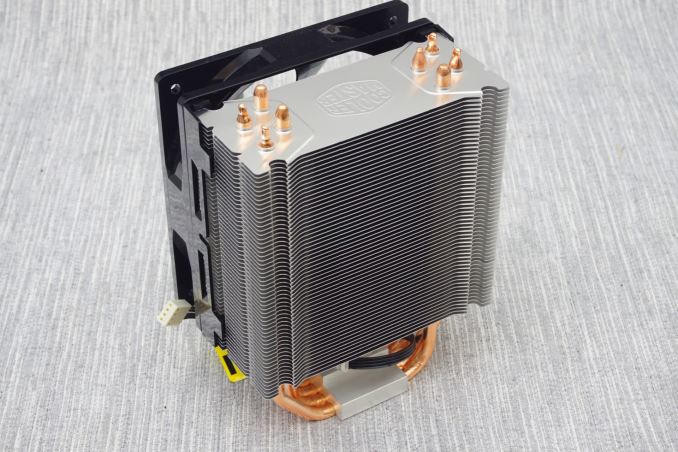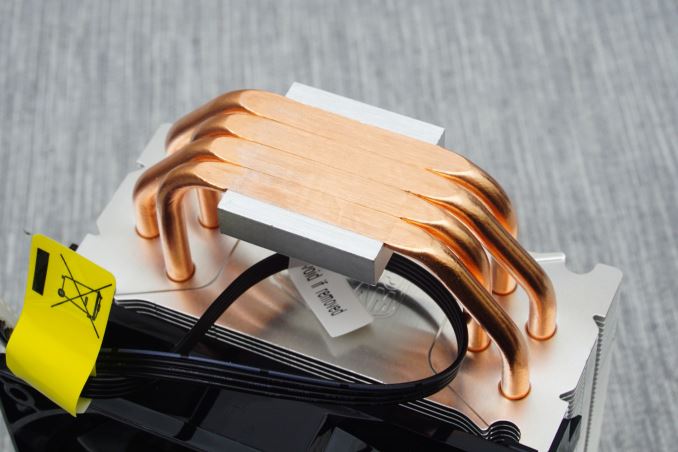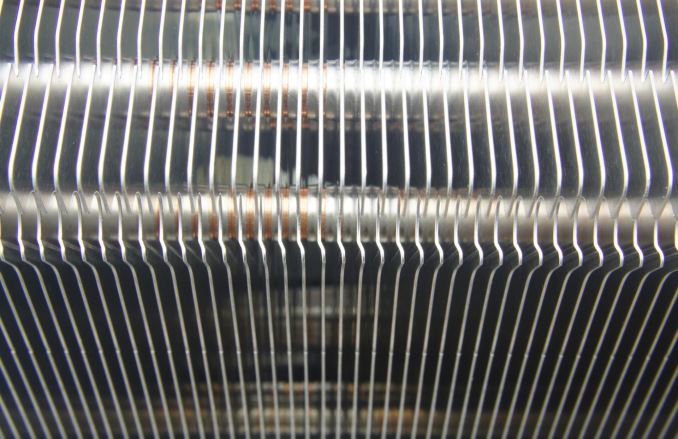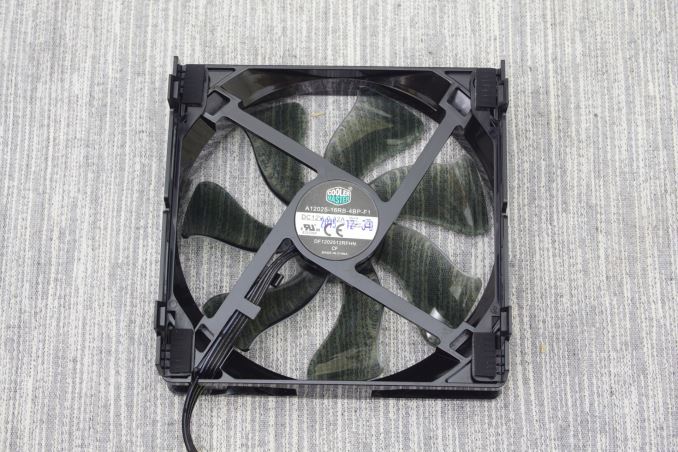Battle of The CPU Stock Coolers! 7x Intel vs 5x AMD, plus an EVO 212
by E. Fylladitakis on July 22, 2016 9:00 AM EST- Posted in
- Cases/Cooling/PSUs
- CPUs
- AMD
- Intel
- Cooler Master
- Cooler
The Cooler Master EVO 212
The Cooler Master EVO 212 is the “special guest” of this review. We included it because it is one of the most popular mainstream coolers, combining good performance with broad compatibility and a very reasonable retail price. Although we do have one more aftermarket cooler in this review, it comes from a CPU manufacturer and is essentially based on the designs of their stock coolers, so the EVO 212 is the only cooler that greatly stands out from the rest.
The EVO 212 is a tower cooler with four copper heatpipes and a vertical 120 mm fan. It is designed to absorb the thermal energy away from the CPU and transfer it to wide aluminum fins using the heatpipes. Then the energy is being transferred to the airflow generated by the fan more effectively, as the surface of the many parallel aluminum fins greatly outweighs that of most stock coolers.
What makes the EVO 212 so efficient and popular is the direct contact design. The heatpipes come in direct contact with the CPU’s surface, increasing the energy absorption efficiency. Copper is soft and easy to damage, thus this design has greatly inferior mechanical strength than most other tower designs that have the heatpipes supported inside a metal base, but this has virtually no shortcomings for most users that will not be mistreating their computers (as well as being indicative of the pricing).
Other than the direct contact heatpipes, the EVO 212 has no other advanced features. Naturally so, as the company wanted to keep the manufacturing cost low. The aluminum fins are inserted to the copper heatpipes and not soldered, while the base is not machined down to a perfect finish. The cooler’s A12025-16RB-4BP-F1 120 mm fan is a small surprise, as it has a rifle bearing engine, an enhanced version of sleeve bearing designs for lower noise and higher durability.
| Vendor | Cooler | Common Bundle | Core | Fins | Fan (mm) |
Mass (g) |
| Cooler Master | EVO 212 | Aftermarket, ≈$30 | Cu +4 Cu HP |
Alu | 120 | 436 |















82 Comments
View All Comments
Cygni - Friday, July 22, 2016 - link
You thought that's what this comparison was about? Really? People swapping stock coolers? REALLY?SetiroN - Friday, July 22, 2016 - link
You don't get sarcasm even when explicitly pointed out? REALLY?ImSpartacus - Sunday, July 24, 2016 - link
I've got a 212 in my machine and I nearly went stock, so this is an absolutely fantastic comparison in my opinion.Very unique & helpful article, overall. It's amazing how such a simple topic can be so deceptively useful.
cknobman - Monday, July 25, 2016 - link
The point of the entire article was to provide information for someone that wanted to use the stock cooler.Heck I'm rocking a 212 myself because I cannot see spending more $$$.
Now if AMD would only bundle a processor worthy of the freaking cooler I might buy one!!!
blackmagnum - Friday, July 22, 2016 - link
Tip: Don't forget to clean the fans once in a while.fanofanand - Friday, July 22, 2016 - link
I think there is one tiny component here that was overlooked, and that is ease of installation. The stock coolers are FAR simpler to install, weigh significantly less, and therefore cause less stress on your motherboard. That isn't a big deal when you have a high-end ROG board or the like, but on cheaper, thinner motherboards not having 400+ grams hanging off the side is pretty nice.ZeDestructor - Friday, July 22, 2016 - link
Have you ever used push-pins? I personally abhor pushpin coolers - damn thing doesn't go into the board half the time and results in needing 4 tries (including cleaning and reapplying TIM) before the damn thing is in....Honestly, I'd pay the extra cost of a half-decent cooler like a Noctua NH-L9x65 or Cryorig M9i just so I can use a bunch of simple, solid screws instead.
PS: even OEMs agree - their coolers are just the reference intel coolers, but with screws and an as-cheap-as-possible backplate to screw into.
jabber - Friday, July 22, 2016 - link
I detest the push pins too. Just cant get on with them.Zap - Saturday, July 23, 2016 - link
Push pins are super simple to use once you figure them out. You can't just place the heatsink on top of the CPU and mash down the pins. That's the path to tears and frustration. I've installed hundreds of them, and can nail the install in one try. They are secure enough that you can pick up the motherboard using the heatsink and wave it around.What you do is to guide the pins until they go through the holes in the motherboard and the base (translucent white part) is sitting flush against the motherboard. THEN you press down on the black pins until they click. Go diagonally, as you would installing wheels on your car. For the first pin, you'll have to hold down the heatsink so it doesn't tilt.
ZeDestructor - Sunday, July 24, 2016 - link
It's a royal pain to line the cooler up when the board is installed in the case since you have no lateral or underside vision to see that the pins are lined up before you can push in, so you basically guesstimate where it is based on pin movement, find it feels like it's in the hole, press down on the pin... aaaaand crunch! Now, you swear some oaths about the bloody moron who designed the damn thing as you find that you've successfully crushed half of the pin out of the hole, making the bloody thing even more annoying to line up successfully blind.No, I'll stick to 4 zinc-plated steel screws tyvm.